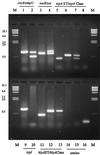Genotypes associated with virulence in environmental isolates of Vibrio cholerae
- PMID: 11375146
- PMCID: PMC92890
- DOI: 10.1128/AEM.67.6.2421-2429.2001
Genotypes associated with virulence in environmental isolates of Vibrio cholerae
Abstract
Vibrio cholerae is an autochthonous inhabitant of riverine and estuarine environments and also is a facultative pathogen for humans. Genotyping can be useful in assessing the risk of contracting cholera, intestinal, or extraintestinal infections via drinking water and/or seafood. In this study, environmental isolates of V. cholerae were examined for the presence of ctxA, hlyA, ompU, stn/sto, tcpA, tcpI, toxR, and zot genes, using multiplex PCR. Based on tcpA and hlyA gene comparisons, the strains could be grouped into Classical and El Tor biotypes. The toxR, hlyA, and ompU genes were present in 100, 98.6, and 87.0% of the V. cholerae isolates, respectively. The CTX genetic element and toxin-coregulated pilus El Tor (tcpA ET) gene were present in all toxigenic V. cholerae O1 and V. cholerae O139 strains examined in this study. Three of four nontoxigenic V. cholerae O1 strains contained tcpA ET. Interestingly, among the isolates of V. cholerae non-O1/non-O139, two had tcpA Classical, nine contained tcpA El Tor, three showed homology with both biotype genes, and four carried the ctxA gene. The stn/sto genes were present in 28.2% of the non-O1/non-O139 strains, in 10.5% of the toxigenic V. cholerae O1, and in 14.3% of the O139 serogroups. Except for stn/sto genes, all of the other genes studied occurred with high frequency in toxigenic V. cholerae O1 and O139 strains. Based on results of this study, surveillance of non-O1/non-O139 V. cholerae in the aquatic environment, combined with genotype monitoring using ctxA, stn/sto, and tcpA ET genes, could be valuable in human health risk assessment.
Figures

References
-
- Barua D. History of cholera. In: Barua D, Greenough III W B, editors. Cholera. New York, N.Y: Plenum Medical Book Company; 1992. pp. 1–35.
-
- Brown M H, Manning P A. Haemolysin genes of Vibrio cholerae: presence of homologous DNA in non-haemolytic O1 and haemolytic non-O1 strains. FEMS Microbiol Lett. 1985;30:197–201.
Publication types
MeSH terms
Substances
Grants and funding
LinkOut - more resources
Full Text Sources
Other Literature Sources
Molecular Biology Databases

